
rat i i i i i i mil pmmm
Arboricola torqueolus, Valenciennes.
TemaeUlar Names-— [Peura, Ban-tetra, Bun-teetur, Kumautt Garhwdl and
westwards; Kaindal, Kangra; Kohempho (Lepcha) ; Kangkom (Bhiitia),
Sikhim 1
ROM the eastern borders of the Chamba* Territory,
and at least as far as the left bank of the Ravi, to
the eastern boundary at any rate of Sikhim, the
Common Hill Partridge is found in suitable localities
throughout the outer ranges of the Himalayas.
Westwards of the Ravi, it may occur. I have no
information on the subject, but it is pretty certain
that it does not extend far into Kashmir, or some one would
have recorded it thence.
Eastwards of Sikhim it may extend into Bhutan, but it was
not observed a little further east by the Dafla expedition, who
obtained only the next species, the Rufous-throated Hill Partridge.
It appears possible that this species may also occur in the
Naga Hills, as Major Godwin-Austen thus finally identified
specimens obtained there by Capt. Butler and Mr. Roberts.
Major Austen, indeed, treats the Naga Hill bird as a variety, but
chiefly on the strength of Dr. Jerdon's erroneous statement
that the legs of the present species are " red" which, of course,
they never are. Primd facie, it might seem more likely that
the Naga Hill bird should be distinct, but as the only distinction
on which Major Godwin-Austen relies is invalid, we must,
for the present, assume the birds to be identical.T
This species, so far as is yet known, occurs nowhere outside
our limits.
T H E COMMON H I L L PARTRIDGE haunts dark, densely-jungled
water-courses and ravines running down the hill-sides, and never,
* It is common in Kullu, and Dr. John Harvey writes from Chamba:" It is
fairly common about the Hathi-dhar Mountains, about five miles north-west from
Nurpur, in the Kangra district, but seems never to have been met with in Chamba,
on the northern side of the Kangra Range, nor have the Raja's falconers ever seen
it above Chand, close to Sindhara, on the Ravi, about 7 £ miles from Dalhousie. I
think it very probable that it crosses the Ravi into Kashmir, but it possibly may
not."
t But note that his dimensions, wing, 5 32, &c , are very small for true torqueolus.